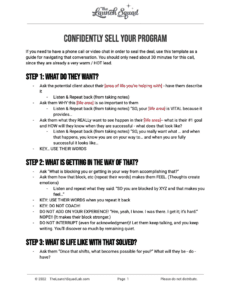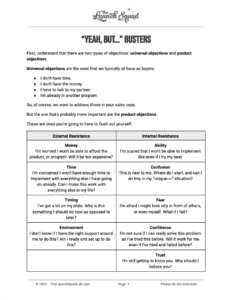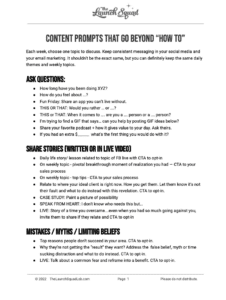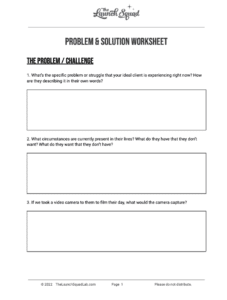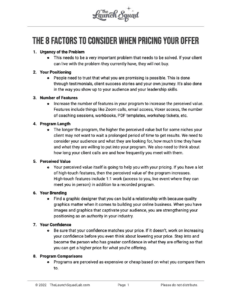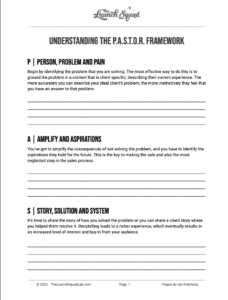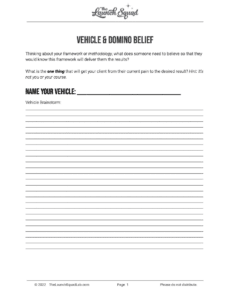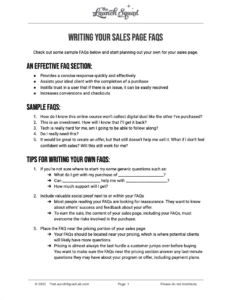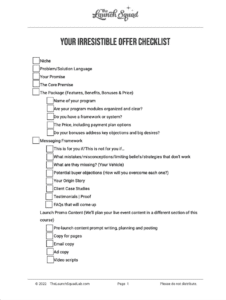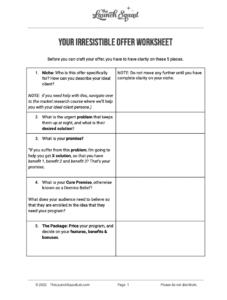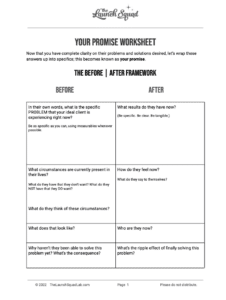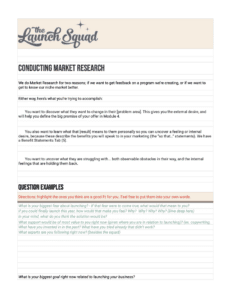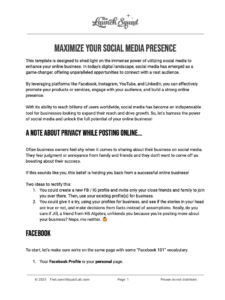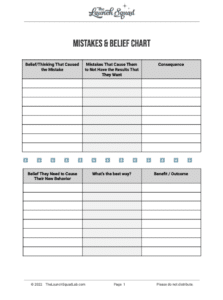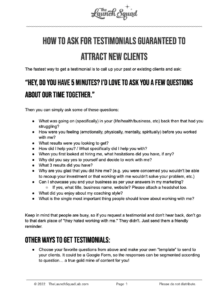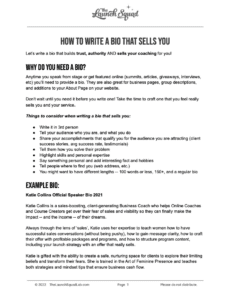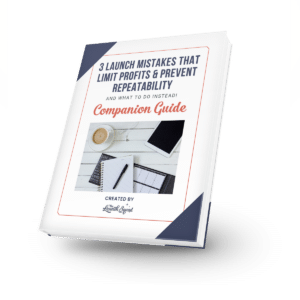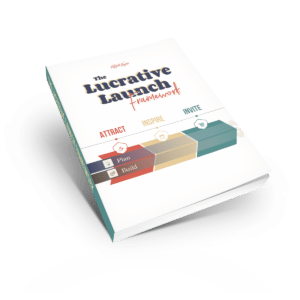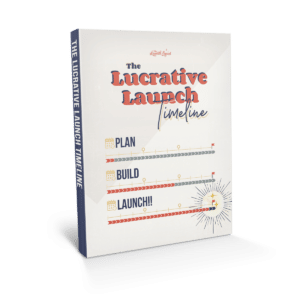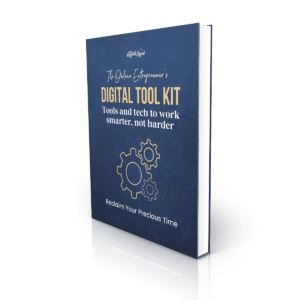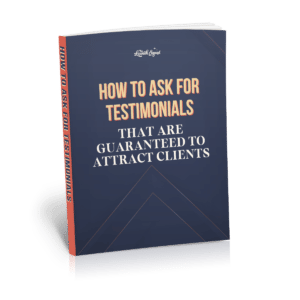[00:00:00] Jeffrey: Welcome to the lighten your launch podcast today, we're talking about when DIY becomes a curse, stay tuned.
[00:00:55] Jeffrey: Welcome back to this show. I'm Jeffrey Samran. I'm back again with Katie Collins. And today we want to talk about DIY outsourcing and hiring a high end professional. Why you would, why you wouldn't and how do you know which route to take. Katie tell us who we're talking to today.
[00:01:15] Katie: Our guest today helps coaches, creatives and entrepreneurs attract their ideal clients and be seen as high value experts. She's often hired by seven and eight figure business owners to create not just a website. But in attention, grabbing personality, infused selling machine, that books, new clients and customers while they sleep, her work is greatly influenced by her experience.
Running a camp at burning man, four times, she isn't afraid to kick up some dust or work her butt off. And those experiences it's inspired her to live by burning visionary 10 principles, which she's incorporated into her own set of values that she lives by each day. Like radical inclusion. Radical self expression, communal effort, ambition, and dedication and positivity and honesty with the greater New York city area as her personal playground, her style and her hair color are constantly changing.
She dances in the streets works till 4:00 AM sometimes and treats her city like a playground. Welcome to the podcast, Laura Elli.
[00:02:20] Jeffrey: Welcome.
[00:02:21] Laura: to be here. And for the record, only two of those four burnings man, uh, were me running a camp. The other two, I just participated
[00:02:31] Katie: All right. For the record. Glad for the clarification.
[00:02:36] Laura: I didn't want my old camp leaders to be like, Hey, there.
[00:02:40] Katie: you know, but I wanted to bring that in, cuz I think it really, um, speaks to a person, a certain personality, right? A certain person type. And it's just that, that openness,
[00:02:51] Laura: Yeah. It's
[00:02:52] Katie: for, all beings and creativity and art and messiness, you know, so I just love that about you. And it was one of the reasons why I loved working with you.
You've helped me build two websites and we love having you on the team at the launch squad. So we're so psyched on, know why it took us so long to get this podcast going, but we're so psyched to have you as a guest so that other people can just hear your brilliance that you, that you really offer.
[00:03:18] Laura: Ah, and I love to provide that brilliance in any way. I can Katie better, late than never.
[00:03:25] Jeffrey: well,
[00:03:26] Katie: the perfect time.
[00:03:27] Jeffrey: Yeah, absolutely. And, and I, I want to, you know, go back to the sentiment of the burning man idea. Like I remember being very attracted to the whole idea, all the cell radical self reliance and all of that kind of stuff and experiencing it and how. Everyone kind of took care of their own, uh, responsibilities and things like that.
Um, of course, you know, until the actually event started, but the two weeks leading up to it were magical. In my opinion, I would, I would go back in a heartbeat to support any artist who wants, needs setup, you know, setting up camps. What I ever it is that was the best time. And then everybody else showed up and I wanted to leave, but
[00:04:09] Laura: And, you know, it really creates an elevated kind of festival goer. Uh, I recently, I'm not going to the big burn this year, but I.
went to a regional burn in Miami. Uh, with my boyfriend a few weeks ago, and that was his first burn experience. And the thing that he kept reiterating to me was how he couldn't believe there was no trash anywhere.
Cuz everybody brings their own cups, their own plates, their own utensils. And so there's, it just creates a really. High end kind of festival because the participants live by these principles. It's not just during the week, it's all year round that they bring it into their lives. And that's really what initially attracted me and also kept me going back cuz it felt very adult having.
Been to music festivals my whole life. It really became like, oh, okay, this is something I can continue into my thirties and forties and fifties. And you know, I'm 34 and I'm definitely on the younger end of people who attend these events. And you can tell even just going into the porta potty, everything is so clean.
[00:05:13] Jeffrey: Yes.
[00:05:14] Laura: That's what's so shocking.
[00:05:15] Jeffrey: And here's, here's what I really like about that idea is that, so in the same way, this humongous event is attracting certain responsible person. Us and our businesses. I think that's another, that's a concept we can take from there and say, listen, I wanna work with great clients. I wanna work with great clients.
How do I create that environment? That's going to attract people that are responsible and great to work with and doing good things and all of that kind of stuff.
[00:05:48] Laura: Absolutely 100%
[00:05:52] Jeffrey: Okay. I, I feel like we're, we're stray from the con con the topic of, of the DIY. And I wanna get back into that. Um, but it's all good stuff. So in, in this topic of DIY, uh, I I'm a DIY or myself. I've been a, for a long time, but I know there's limits. I know I have limits. I want to start this conversation with, you know, when does the DIY mindset become a curse?
Like when. do we start? Where do we end? And let's
[00:06:23] Laura: I mean, depending on how tech savvy you are, that curse can set in real early. Uh, and I mentioned this to you before, but when you. When you start to procrastinate on these little things like putting together social media posts, cobbling together, a logo based on a template. If you're procrastinating on this stuff, it probably means that. you're not super confident and you're not ready to do it yourself. So be mindful. That's my first piece of advice is be mindful of your state when you're even just thinking about doing this stuff and whatever you really don't like to do. Sometimes you have to kind of brute force yourself and be uncomfortable as an entrepreneur. Half of what we do is just getting outside our comfort zones, but when to outsourcing, especially design and tech.
Based stuff or even copywriting, you know, any sort of creative skill that just is outside your wheelhouse. It's okay to find some help. It's okay to find some support. But if you are somewhat tech savvy, then that, that you're probably wanting to DIY in the first place.
[00:07:37] Jeffrey: Yeah.
[00:07:38] Laura: you know, there's a lot of tools out there to help you do that.
[00:07:41] Jeffrey: one of the main re uh, areas that I see. Business owners, coaches, and course creators. They start, uh, doing their own thing and DIYing it like back in the day, WordPress was like the only game in town pretty much. Right. Uh, but now we've got all these other platforms they're really easy to just kind of jump in and get started really quickly.
Um, So, so tell me about your perspective on these alternatives. There's WordPress there's, you know, whatever Julin or, uh, Wix weeley Squarespace,
[00:08:17] Laura: mm-hmm
[00:08:18] Jeffrey: uh, where do they play a role? Where do they not play a role?
[00:08:24] Laura: it depends on your business model. I think that for let's just say event photographers. And I mean, even restaurants, they can really benefit from these DIY builders like Squarespace and Wix, because they already have a strong visual component to their brand. Just by way of photography, a alone, a lot of the templates are provided on platforms like webl Squarespace.
They are very photo centric.
[00:08:58] Jeffrey: mm-hmm
[00:08:58] Laura: And it can get really old having a website. That's just a bunch of stock photos. So if you do have really strong brand photography or have photography showcasing your business, like a restaurant, a venue, those are the sort of. Businesses that can thrive easily using those platforms.
But I think other businesses, like if you're a coach or a co course creator, you're gonna feel very limited very quickly because they don't specialize in stuff like funnel, building, landing pages, versatility in. The types of pages you have, for example, you can't really create a membership course using Wix or Squarespace.
You can sell products and they have a good way for you to offer your, your products via an e-commerce, uh, shop that's built into the platform, but unless you have a physical or a digital product, It's gonna be a lot harder to get people in have that sort of sticky marketing that it takes to make it as a course creator, or even as a coach.
Any service based business is gonna need more than just what these services have, which means that if you start out using these services, you're gonna have to move off them eventually. And it's going to be a pain.
[00:10:26] Jeffrey: Uh,
[00:10:26] Laura: it for so many clients and they hate it every time.
[00:10:30] Jeffrey: yeah, right. Let's let's talk about that cuz uh, Katie, how do you
[00:10:35] Katie: I'm laughing cause I'm like, oh boy,
[00:10:38] Jeffrey: do you have any thoughts on that, Katie?
[00:10:39] Katie: uh, I raised my hand on that one. Um, you know, I, I was sharing before the show. Um, you know, when I first got started, I got a square space site built for me. I think I spent $2,800 on it, which was the right price point for me at the at time. And, um, then I met, um, a new web designer and he was saying.
I got on his email list and he sent out this kind of urgent. He's very good with the urgent stuff. Um, you know, urgent, if your Squarespace website is not built on, you know, I don't know, Squarespace seven, which mine wasn't, then it's not gonna be mobile friendly. And I wasn't ready for a new website at the time.
I knew I was gonna be re and doing like a major. Like shift up and I just wasn't ready to get that in, in a website. So I was like, oh, okay. Let's take the easy way out and just have him take my current website and, you know, upgrade it to, I just figured it was like duplicate shift a few things and hit go. But no, no, it was not. And it went far over budget, which he never shared with me until he sent me the payment due.
[00:11:48] Jeffrey: Oh, ouch.
[00:11:50] Katie: And I ended up having to do a payment plan with him for like a year, because I just was not prepared for how much it cost me. And then fast forward a year later, I hated my website. I rebranded everything.
And that's when I hired you, Laura. So yeah, it was like, I probably spent $10,000
[00:12:07] Laura: Oh, Katie.
[00:12:07] Katie: on website stuff right. In like a two year period.
[00:12:12] Laura: Oh, Katie, that's terrible. My heart goes out to you,
[00:12:16] Jeffrey: like they're watching a slow train wreck.
[00:12:18] Katie: Oh, it. You know, and I will say it's funny, even though it was like a painful and sort of expensive lesson when I got my website designed by you, Laura, you know, and I had had a branding upgrade by somebody else. So I brought the new brand to you. Um, you know, which, um, was fine, neither here nor there.
Right. But you really had yeah. Something to work with, but I remember getting that website and being like, here she is. Right. And I also got a bunch of new photos done. And I, I just can't agree more how important it is to have photos that reflect your now personality, right clothing that reflects how you wanna be showing up.
And just that you feel gorgeous or whatever, however you wanna feel. Right. And I think that was one of the questions you originally asked me. How do you want people to feel when they come to your site? And I just really wanted to be seen as a leader and I wanted, and I was finally starting to take myself more seriously, um, and all the things.
So anyway, I just remember getting that website and being like the, there she is, right. Like in all her glory
[00:13:21] Jeffrey: when you feel represented.
[00:13:24] Katie: yep.
Yep.
[00:13:25] Laura: That's huge. That's huge.
[00:13:28] Jeffrey: Laura. Can you talk to that idea? Like if you were to meet Katie back when she had that square space site and she was like, oh, but I've already sunk so much money into this. I just gotta ride this out. Maybe I, since I've, since I've invested so much into it, I, I, I have to have it.
I have to, you know, ride this out, cuz I've already sunk so much into it. Like. Let's explore that mindset. What are the alternatives? What, what can people do at that point? I'm sure Katie's not the only person who's ever done that.
[00:13:58] Laura: No, and I've helped out so many clients get out of this exact situation. It's it's the sun cost fallacy at play in our entrepreneurial lives. We are so determined to make that investment worth it. Even if it wasn't the right investment that we just keep plowing forward without any real awareness of whether we're on the right track or, or not. That's I think what's so hard about DIY as well, just to tie this back into that is that if we've sunk so much time into doing stuff ourselves, if you are on the tech savvy end of things, and you are convinced like, okay, I'm just gonna do this myself. Like when is it okay to pull the plug and say, okay, that cost is sunk.
That time, that money that I spent on the designer that I don't really get along with, or that website that I don't really like, when is it time to just press eject and get yourself out of that situation? And honestly, there is no right time. It's all about letting go. And when you're mentally prepared to cut your losses and move forward and not feel guilty about it and understand that that's just part of doing business it's part of trial and error.
Uh, with that in mind, I encountered this somewhat recently when I first started. Designing WordPress sites and I've designed for square space. Weedly all the above, but I mostly do custom WordPress sites because that is the most versatile platform that there is. And it's pretty objective in that regard.
But when I first started back in, I'd say 2012 building WordPress sites, I used what was at the time, a very robust platform. Called optimize press two point. Oh,
it wasn't even 1.0 it was 2.0. And that should have been the first red flag. When I saw that their 1.0 platform was no longer supported and I had to use their 2.0 platform.
Well, fast forward to 2019 and they released 3.0. So I had built. Massive websites for some of my huge, like seven figure clients, where they had hundreds of pages, hundreds of sales pages, landing pages, their entire website built on a platform that was no longer supported. And I was so in denial for so long.
And finally I reached out to all of them and I said, Hey guys, listen. We've come a long way since 2012. And here is the research I've done. I have a new platform that I would like to move you to. It's not gonna be free, but I will cut you a deal because I feel real bad about this. And I had to basically admit my mistake and say, I can't.
I can't support your website anymore. I'm gonna have to just remake it. And you know what a lot of them said, they said, that's fine. Let's redesign it while you're added. And they took the opportunity and they said, okay, well, okay, I have to make this new investment. I have to cut the losses on all the money I spent over the years, building out these, say sales pages in a builder.
That's no longer supported, but you know what, I'm gonna take that opportunity much like Katie did. and up level everything in the process because where your business is now is probably not where it was when you did that DIY website, or when you spent that money on the five designer and don't get me wrong.
There's a lot of fine fiver designers. I'm just, you know,
[00:17:41] Jeffrey: Yeah, we're not, we're not bashing on fiber.
[00:17:43] Laura: promoting, you know, finding a long term collaborator that you're probably not going to find on those platforms, but. Anyway. Yeah, that's what it comes down to is. Okay. I have to spend the money again, but let's make it worth it.
Let's take the
[00:17:59] Jeffrey: Yes. Yeah. I, I think that's, I've, I've ran into that issue before and like, you know, there's, there's no amount of, you do have to give your yourself grace on that. There's no amount of research that you could have done that would've predicted a company no longer supporting their product and you know, whenever, but yeah, gosh, that's a hard position to be in because of course you're customers.
Aren't like, oh, I, yeah, that's fine. I get it. They're like, no, you. You said I should do this. Uh, it's a, it's a hard, hard position. Um,
[00:18:31] Laura: Much like with Katie Squarespace.
[00:18:33] Jeffrey: yeah. Right,
right.
[00:18:35] Laura: Oh, Squarespace is just upleveling their entire. And I remember being so frustrated with that exact move from Squarespace and they got a lot of flack for it, but, you know, that's just how it works with these mega builders. We're just now I think in the PAs couple years at a time where builder page builder technology.
Has reached a bit of like an apex. And I say that now, right? Let's let's see if that ages well
[00:19:03] Jeffrey: yeah,
[00:19:04] Laura: like the builders,
[00:19:06] Jeffrey: the way.
[00:19:07] Laura: builders, like Jeffrey and I use Aveta and Elementor, and even divvy to some degree, these are really high end products that have perfected their art in a way that optimized press 2.0, never did.
[00:19:21] Jeffrey: no. So, so. Speaking of the, the DIY, what specifically should coaches and course creators, you know, most business owners not attempt to DIY. Where, where is it? Where do we, you draw the line? Just don't do it. Don't go there. It's not worth your time. It's never gonna turn out. Well.
[00:19:43] Laura: If you're, if you don't have design experience, I would say don't DIY your logo. It's easy to just grab a template and stick some stuff on. And if you're just starting out, then that might be the way to go. Uh, in fact, I offered DIY templates that include logos because when you're just starting out, keeping it.
Simple is the way to go. But if you've been in business for a year, you're starting to really market yourself. You're starting to get out there. Then I don't recommend DIYing anything. That's going to take your attention away from your core. Value from delivering value to your clients from producing new products, from marketing yourself, from getting out there, doing the PR, Right, So that includes stuff like templates for a virtual assistance, so that you have consistency in your marketing that is worth outsourcing even. And. Upfront, you might want a DIY. It is worth it to have standout templates that will last you in your business and maintain consistency across all platforms.
Getting that branding done, getting the color palette, the fonts, the logo, spending a little bit of money on that will go a long way. And it just means you're not going to have to redo it every year. right.
Because you're not a designer, that's just not what you're good at another really good thing to delegate.
And this isn't my field, but it's something that I see a lot of people attempt to do on their own. And it just backfires is copywriting. Unless you have copywriting experience or you've written marketing language blogs. If you don't have that experience and you're like, Oh I can just do it myself. It's not going to come across as high end, and you're probably not going to get the type of clients you want because they're not really seeing the best of you. Right.
They're not seeing what a copywriter would write about you. You're they're just seeing, especially coming from a corporate background, trying to be your own copywriter. Is brutal using all that corporate jargon writing way too much. I mean, I provide copy editing services for some of my clients who would rather write their own copy and thank goodness, I'm there to like catch a lot of this stuff because I will oftentimes take 10% of what they write and they ATS the website.
[00:22:15] Jeffrey: Yep. Yep.
[00:22:16] Laura: It's about skimming.
It's
[00:22:18] Jeffrey: And here, the thing is, you're looking at that from a sales and marketing perspective, you know, they're, they're looking at it from, this is what I do. This is the service I provide. This is what I'm good at. This is my specialty. This is where I've gotten training. This is why I'm credible. This is why I'm an authority.
Like, and, and I, as you listening to that, there's a few pieces in there you might wanna make or, or take from that. But largely nobody cares about it, you know?
[00:22:47] Katie: You know, what's, what's interesting that I've, I've found lately. Cause I've been really digging into copy. I've been studying it. And I've been looking at who's do I like, why do I like it? And there's this feeling that I get, it makes me happy when somebody writes copy, that brings happiness in me. Like either it was funny or right.
But something that happened inside me where I was like, I really like the way they said that I instantly liked them better.
[00:23:12] Jeffrey: Yep. Yep.
[00:23:13] Katie: So that, that's just an example of how the importance of that copy. And I think for something like your website, that's gonna hopefully last at least two, three years of your current brand.
Um, I think it's a worthy investment to get someone who can write like that. That's gonna make people feel happy when they read it.
[00:23:31] Laura: Absolutely. I mean, the three major components that go into a super high end website are photography, the design of the website itself and the copy. Right. And, and I say design of the website, but I really mean design and development because having a really beautiful website that takes forever to load is obviously not a successful website.
Right. Right. But that I kind of bundle into the design development component, but I mean, with those three factors, Those are going to be the three pieces that are most worth investing in once you're ready to drop a little bit more money and see your brand like push itself forward by way of having creative, consistent, and compelling copy design photos, all the above.
[00:24:20] Katie: You know, and I, I wanted to also say that like about the branding, um, you know, when I got my square space, seven website, air quotes um, you know, and I had this belief. That I wasn't ready for that brand. Like I could feel that I was up-leveling, but I wasn't quite ready to put those words on paper. And, and I think it was a financial decision.
Like I didn't, I couldn't afford someone to do a brand for me at that time, but I just wanna say, when you do invest in someone to help you up your brand, it forces you. To answer the questions and get your clarity. And so sometimes you might skirt around not really having a very clear client avatar. For example, when you go through a branding process, you all of a sudden are forced to be like, what are my values?
What do I stand for? Right. Who is it that I exactly wanna work with? And let me put, put the stake in the ground. So I just feel like people who think they aren't ready, it's kind of like, you're ready when you work with someone who guides you through it.
[00:25:24] Laura: Yes.
absolutely love that.
[00:25:27] Katie: Yeah.
[00:25:27] Laura: It.
[00:25:28] Jeffrey: Okay. So I think I want to come back to that topic, uh, in a minute. Uh, but you said something interesting and it was kind of about the, uh, the timeline of, of where these things fit in. So let's talk about, uh, you know, there's, there's a lot of great templates out there. You mentioned templates, you mentioned, mentioned spending money on design.
You mentioned all of these different things, but, but where. In the timeline, do these things really fit in a, in a, let's say a coach, a coach starting a business, or, or, um, you know, maybe they've, you know, in the, the life cycle of a business, let's talk about the timeline. Like when do they do DIY, when do they do budget things?
When are they splurge for a designer? When do these things happen?
[00:26:19] Laura: Okay. So again, it really depends on your degree of tech savviness as an entrepreneur. If you feel confident in DIY, then you can get these basics out yourself, using templates available for. Website builders like Squarespace or lot. There's so many templates available for Aveta and Elementor with WordPress.
It really makes such a, a difference having that template there. So you're not starting from scratch. So if you're confident in building those things yourself, then you could get pretty far with a DIY, but otherwise I would recommend splurging just a little bit on like a lower. Ticket website and brand, uh, right off the gate because using those brand standards, using the colors, the fonts, the logo that you pay for, and you don't have to spend a ton of money.
This is something that you can hop on Upwork and get done for anywhere from 300 to $600. But getting that foundation built is going to be such a shortcut for you. And then you can, and this is, I would say within the first six months of being in business is figuring out, okay, what can I DIY, what would I like to hire out?
So getting a, a lower end or a lower ticket. Less price designer on board to just get the foundation built is going to allow you to then hire a virtual assistant. And then that VA can take the brand standards that are put together, uh, the colors, the fonts, everything, and just rock Canva. And you can get so far in your marketing, just having using canvass templates or even.
Templates purchased from a platform like creative market that are for Canva, so that you're not just using what's available for Canva, because then everybody's using those. But having your own colors, fonts, patterns, logo to just drop into those templates is going to bring you pretty far. And that goes for the website as well.
If you just. You know, build a WordPress website and have some nice Elementor or Aveta themes that you use as a jumping off point. And then just plug in your own. Copy your own colors, your own logo. Then you can get pretty far within your first one to, I would say three years of business. It's only once you've started to really dedicate your whole self to your business when you've quit your day job.
For example, when you've hit your first six figures in a year from your business, that's when you can. Start to look back and say, okay, that lead pages funnel, that click funnels funnel that I've been using, that my VA set up for me, how can I upgrade this? How can I maybe raise my rates and make it look the part, I think that's when let's say three years in business, that's when people really start at looking at their services, their offers and saying, okay, I have my proof of concept now.
You know, the imposter syndrome has been shrugged off as much as possible in your first five years of business. Right. Uh, and then they say, okay, well now I'm ready to reinvest. I can move forward and really have a brand and spend a little bit more money on a website that represents where I want my business to be.
Or in some cases where my business is now I've been brought in for some of my, you know, huge coaching clients I've been brought in. They've already made like. $700,000 in a year from their business, but they don't feel like their brand represents them. And that goes a long way towards inspiring them to find a designer that they can work within the long haul that you know, can really make the decisions for them and up level the, a brand to the point where they can double their rates or take on more high end clients and feel like they're really putting.
It out there like, okay, I am deserving of these rates. It's a psychological thing, as well as a, a monetary thing. Right? A lot of people aren't going to want to spend a ton of money on a business that they don't perceive as being high end and the, the website, the branding, the photography, the copy of that goes into that perception.
[00:30:56] Jeffrey: Hmm, absolutely. Now I want to touch on that, that point you just made that, you know, at some point they're going to, um, not only splurge on somebody, a professional who costs more, but. They're developing a relationship. So, so talk to me about what really separates a high end designer, high end professional from, um, you know, very capable designers on fiber and Upwork and stuff like that.
So what is that separation?
[00:31:30] Laura: Oftentimes the price point itself will give you a hint as to how many clients, a designer or any creative professional will be taking on at once. So for someone like myself who charges anywhere from a hundred to $150 an hour, I only take on a few clients on a regular basis. And so they get a lot more of my time.
[00:31:55] Jeffrey: Mm-hmm
[00:31:55] Laura: And when you hire a designer for anywhere from 30 to $50, you they're gonna have to take on a, to a ton of clients to really make it worth it in their business. So oftentimes you're going to have greater lead time. You're going to have stuff that hasn't been fully fleshed out. It stuff may seem rushed.
Um, and so you really get what you pay for a lot of times, but you can strike gold. You can find a designer who's maybe only been in business a year or two they're charging 40 to $50 an hour. But their work is spectacular. You can seek those clients out or those, uh, those service providers out, but it's not necessarily what you're going to get.
And so there is a degree of luck involved. And when you raise that price point, the luck becomes more certain like, like, okay, if I'm paying a hundred dollars an hour for creative direction for brand design, for logo, web, uh, web design. You're more likely to get a final product that you are thrilled with because you're putting your money where your mouth is in that regard.
[00:33:09] Jeffrey: I love that. I love that. Do you feel like a, a, a website is kind of a one and done thing once you, I mean, , I think a lot of this conversation has indicated otherwise, but I want to talk about the idea of an evolving website. Like I've had people talk to me about like, uh, you know, clients who, who, if I built them a website and they didn't like it, they would go to another designer and hire 'em to build a completely new website.
Without understanding that you can change a
website.
[00:33:44] Laura: I think a lot of people just to talk about feedback real quick, because I, I really want to. I, I, I wanna impress upon everybody listening, how important it is, to be honest with your feedback and to work with a designer that you feel comfortable enough with, to be honest and upfront with and. It's okay to tell someone, Hey, I'm not really feeling this design.
Can you try again? And here's a bunch of inspiration to point you in the right direction, right? It's one thing to say, I'm not feeling this and quite another to say, I would love it. If you went in a different direction, here's a few examples, right? That's the differe between a bad client from my point of view, a client from health, so to speak and.
A good client is that they're both upfront and honest. Right? In fact, I would say that a bad client is also somebody who goes along with things, doesn't provide feedback. And then at the end of the project complains that it's not what they asked for. Right.
[00:34:49] Jeffrey: Yeah.
Right,
[00:34:50] Laura: have to be honest, but you also need to be detailed about your vision, about what you want.
And a lot of that comes into our process as well. Like for me, I've put a lot more emphasis over the years on the upfront branding and figuring out what drive as my clients, what kind of brand they want. right. So my. My whole framework has evolved over time. And that's also what my clients are paying for.
That's also what you're dropping more money on later in your business. Right. Um, but when it comes to the question you asked, um, which hold on, let's, let's bring it back to what you were saying here. Uh, because I feel like I, I got derailed talking about feedback.
[00:35:45] Jeffrey: well, just really quick, cuz I got a funny story about feedback back in my it's quick back in my early days, I had a client that would describe what he wanted in, in terms of flavor. So he would say, I want something, this is great, but can it be spicy? I want it bold, not too spicy, but not mild. I want it to punch, but you know what I mean?
You know what I mean? And of course, no, I don't know what you mean. I can't take any action on that. can't taste it. You can't taste it, dude.
[00:36:15] Laura: I can't design based on your feelings.
[00:36:17] Jeffrey: Right? Right.
[00:36:20] Laura: no, it's, it's, it's so true. It's so true. And that's why having visual examples, even if you're not a visual person hopping on Pinterest and just grabbing a bunch of stuff that looks good to you. Even if you can't really put a word to why it looks good, having those visual examples, when you're working with a visual designer.
It goes so far. It really does. And it really makes your investment go a long way as well. Um, if, but if you have that back and forth and they're just not getting it. Sure. Find a, find a different designer, right, Sometimes it's just not a good fit personality wise and that's
[00:37:01] Jeffrey: right.
Yeah.
[00:37:02] Laura: It, it really is fine. Um, but ultimately at the end of the day, you really want to, I would say interview a few people when you're seeking out high end design photography, copywriting
[00:37:17] Jeffrey: Because we are talking about building a relationship with that person. We we're, we're talking about building a long term relationship and getting to know them and them getting to know us because there's some, there's a lot of give and take there and, and back and forth feedback. Yeah.
[00:37:30] Laura: That's right. It's the one and done versus the ongoing collaborative relationship. And when you're early on in your business, it's okay to seek out a one and done website, which I, I have to make a point. If you are in that phase where you just want a website up and then you're gonna go off and do your own thing, that's totally fine.
But make sure it's something that you can feel confident in editing so that you don't. Have to bring back a high end developer to like write code, to change various pieces of the website. Like you wanna feel confident in the builder that they're using in your ability to make updates. I highly recommend asking a designer if they don't already offer this.
At the end of the project record a video training, make sure you have it somewhere available so that you can go back and watch it later. It makes a huge difference. But if you're at the place in your business where you're ready to make that commitment, because you are a. Always developing, always growing, always creating new courses, new products, new programs, then it's not, it's never just going to be a one and done at that point in your business.
So that's when it is much more worth it to vet. People find somebody whose vibe, whose personality meshes with yours, their portfolio, especially for photography and for, um, web design, make sure their portfolio is something You like. because even though we are versatile in the styles that we use it is, is very much something that comes from within.
We all have like a style. That we work with, if you are a very visual person and you wanna have a really. Like out there, uh, exploratory creative website, then finding somebody who's very clean and minimal and all of their projects are very clean and minimal. You're probably not going to get them outside of their box.
In that regard, you definitely want to feel connected, not only to who the person is, but what their work looks like.
[00:39:37] Katie: You know, and I wanna chime in too. Just, um, since you guys can talk at
[00:39:41] Jeffrey: Oh, Katie, you still here.
[00:39:43] Katie: col I'm here, I'm here, guys. Hey, um, you, but just from the perspective, Of like someone that doesn't feel comfortable doing DIY pretty much anything and stopped doing that a long time ago. Um, with the exception of Canva, um, And so I can get into WordPress and maybe update if I found a misspelling, that's about the only editing I'm gonna do.
Um, so I think it's important to really identify yourself as like, do you want to do this? Um, or, or have a VA who can, and, or having. A relationship with someone like you, Laura, when say like bots were taking over my site. Right. Remember I had like thousands of comments on my blog that were from like Russian bots.
And every single time I tried to delete them myself, it would just not only crash my website, but it would like crash my computer and it just gave up and it felt outta. All right. So just things like that, where you wanna have somebody that you can co contact and say, can you please help me? Rangle in my website, once again.
And the last thing you wanna do is hand over your website, password to someone you don't already know, like and trust. Right? And so I really appreciated having the relationship with you where you could, you know, of course I would pay you for what you had to do, but help me. Right. And that I already trusted you.
So I think those things are really important. The maintenance of your website. Um, you know, if, if somebody does happen to, to get into it and mess with it or whatever happens again, I can't even talk about what happens cuz I don't understand any of it except uh, my website broke could you fix it? Right. So that's just another kind of chime in for, I think the importance of having that ongoing relationship, even if you don't see yourself needing it, it's
[00:41:29] Laura: the time. Right?
[00:41:30] Katie: me.
you'll need it.
[00:41:32] Laura: You will need it. at some point. Absolutely. And, and also, um, just to bring it back to the part of our conversation when we were talking about the timeline, right. And I mentioned like, okay, the DIY to get yourself up and running in the first. Six months or so there is a gap in your business between that initial DIY phase.
And when you're ready to drop some money on a high end designer to like be on your team. When you can find a tech savvy VA, who's familiar with WordPress or score space websites who knows how to use Canva to populate template eight, using your brand colors and logos, having a high quality virtual assistant.
To get you not only far in your business, but also get you from that DIY to high end creative professional gap is going to be so important. And it's something I recommend for everybody, my clients, even my seven figure coaching clients who. Are really, they're always launching new products and marketing themselves.
They have a VA who's been a part of their business since before even I was working with them. And that VA is able to grow with. The, the, the coach with the, the business owner over years and learn new skills, their ability to learn their ability to pick up design and tech stuff quickly is a huge.
benefit to really putting that effort into finding a good VA.
And then, and then I come in and I work with the VA too. I will oftentimes reach out to a virtual assistant or they'll reach out to me on behalf of my client and say, Hey, Like this has gone. Hey wire, can you help me fix this? And then not only will I fix it, but I'll put together a training video for the VA.
So that next time they can just do it themselves if it's something easy. right. Um, and that is the mark of building a strong team is having the hub, Right. It's a virtual assistant or some sort of, uh, assistant in that regard. And then having the higher end creative professionals that are there to really offer their own individual expertise.
You know, I'll come in and fix that, that tech snafu that a virtual assistant is probably not gonna really know what to do with.
[00:43:53] Jeffrey: Right. I, I, I, I think this is where we, you and I really kind of connected on on at first is that we both approached our businesses from both, uh, a design perspective, uh, a coding perspective. Um, you know, we, we, we both get to understand and have an affinity for, you know, The the entire, uh, ecosystem of, of, of a, of a business and a web presence and a marketing system.
And, uh, on both the technical side of things and the logistics side of things and all of that, I love that you bring that to the table. And I think that's really where. Uh, some of us here in the business can stand out because it's not, when somebody comes to us and says, I, I need a website. Yeah. We can facilitate that.
Right. And that's what a lot of people are doing. They're saying, Hey, you know, Soandso, can you build me a website? And then they're like, what do I do now? I gotta look for a marketer or I can, now I've got a website. I gotta look for a designer. And now I got a designer I gotta look for. And, you know, but we come to the table and we say, listen, I know enough about all of these different things, where if I can't help you specifically, I know who to, uh, either outsource, you know, or like introduce you to the right person.
Or I'm gonna pitch in my 2 cents and that'll get you to the next stage. And then, you know what I mean? Like
[00:45:24] Laura: yeah.
it's a big picture. We, we see the big picture. We see what it means to have a, an online empire, right? That, that, that incorporates all of these various pieces. The membership site, the sales funnels, the promotional website, the branding, all of that stuff, how it all fits together. And I think that that can overwhelm a lot of people when they're just starting out.
So having even, even if all you're doing is. Spending that extra money on a nice brand, a nice logo, or even like sales page copy. Right? If you can hire somebody who knows the bigger picture, and you can tap into that as a source of education for yourself, right? If you don't have a coach, coaches do this as well, right?
[00:46:09] Jeffrey: Mm-hmm
[00:46:10] Laura: This is what, this is what coaches like Katie are so good at is knowing how all the pieces fit together and being able to kind of point you in the right direction. But we, as high end service providers, Offer that as well. For example, a client of mine, she, uh, her VA accidentally sent out an email that was like, meant for people who had like credit card issues.
And because it got sent out to like her entire 40,000 person list and they got hundreds of unsubscribed and it tanked their email deliverability as a result. And so she came to me like, Hey, I need email deliverability. I need like, This specialty. And I said, okay, well, I recommend going on Upwork and finding somebody who is an email deliverability specialist at 100 to $300 an hour, and they'll be able to come in and fix this problem in about five seconds.
Whereas I, I could solve the problem myself and charge my hourly rate. right.
But I know that it would be better for my client to. Solve the problem herself and, and have somebody on hand that does this professionally and to seek me out just to help facilitate the conversation and, and like provide tech, like other tech support, Right.
To kind of be involved in the conversation.
[00:47:30] Jeffrey: w we end up being that first point of contact, that first point of trust for somebody to say I'm having a problem. Where do I go? Do, can you solve this or should I hire? Right. And you're coming at it saying either a I'll fix that for you. No problem. It's mine with a house or
[00:47:47] Laura: or
[00:47:48] Jeffrey: here's who you should talk to.
[00:47:49] Laura: Yeah. Yeah, exactly.
[00:47:52] Jeffrey: So as, as a business owner, as a coach course, creator something, how do we. You know, we've talked about this whole journey of, of getting all of this built up and starting a business and all that kind of stuff. How, how do we identify where we are in the timeline? What, what should, how do we know what our next investment should be?
[00:48:14] Laura: Well, I do have a quiz for that.
[00:48:16] Jeffrey: Uh, tell
[00:48:17] Laura: if I may plug my quiz. Um, yes, it's, uh, it's at design mastermind.com/biz quiz B I Z Q U I Z. Um, and. Honestly, the only reason I put this quiz together is because I get this question all the time. Like, okay, I am just starting out, but I really want to look high end right off the bat.
What is the best place for me to put my money? Right? Or, uh, let's say I'm, I'm only making $5,000 a month in, in my business right now. Like, what should I be investing in to really make it go as far as possible? And, um, I would say there's basically four stages of being in a business and that's kind of what I built this quiz on is there's four results.
That, that you can have. Um, and those four stages are first of all, the foundational stage where you're really, you're just starting out. You're in the first six months of your business and you really just have to get the core components of your brand up and running. And that's when you can get a template website for $2,000 is that's when you can spend $500 on like a nice logo.
And color palette just to get yourself set up and have a place to promote yourself. Then the second stage is I would call the marketing stage when you're really putting the pedal to the metal and getting out there, networking, going to events. Fingers cross that age as well. um, being on social media, developing your voice as a business owner, and that's when it's worth it. to invest in templates like free resource templates, sales, funnel templates, um, ClickFunnels lead pages, all of those marketing, uh, pieces.
Even keynote templates or, uh, canvas slide, deck templates, putting a little extra money in getting those templates done so that you're, you just have them, I would say that's six months to two years. And then also in that stage, you have the sales funnel stage, which is really where the launch squad comes in.
And that's when you guys come in and say, okay, you have. A high ticket program or a course, and you're ready to have a successful six plus figure launch. Right. That's I would say the third stage where you've done a lot of marketing, you have a bit of a list at this point, and you're ready to put that.
That sales funnel to use. And then you're dumping money into the funnel itself into the design, the development, the copywriting, the photography, right. And all of that effort is going into selling a specific product course program, whatever. And of course that's where the launch funnel really steps in or the launch squad really steps.
And, uh, and then the fourth stage is the online empire stage. As I like to say, this is when you've been in business, usually over. Three to five years. Um, and you have a couple products, you have a signature program. You've really stepped it up. You're making over six figures every single year that you're in business.
And that's when you're ready to step it up and really create a high end brand. That's when you see people spending. $3,000 plus on just a branding package, because that's when they're really digging into these core components of, okay, who is my ideal client? How can I fully represent myself in a way that appeals to them?
It's when I see a lot of people coming to service providers like myself, willing to spend $7,500 plus on a website because they want that framework. They want to dig in and have a website. That's going to last them a long time because they have the money to spend and they want their website to represent where they are now, not where they were when they first started.
And did, did it themselves or. You know, did it with a cheap template or something like that.
[00:52:32] Jeffrey: Yeah. And here's the thing. I, I feel like, uh, this is mirroring the conversations we've had about copywriting with like Danny page and things like that. Where, where, when she's talking about, you know, why, why does it cost this much? You know, I'm putting my a hand up at a certain level. Why does it cost this much for certain copywriters?
And then my. Hand goes up and then this much for other copywriters. And it's that, that amount of research that goes into it. And what you're speaking to is that when you get to a certain place in your business, then you're investing in further research and further development and deeper dives into a lot of the things, you know, you kind of, you've kind of dabbled into, get to where you are at that point.
But what you're talking about is that next level is essentially the next level in research in a lot of different areas.
[00:53:27] Laura: about. Yeah. And you're not just paying for their skills as a creative professional, you are paying in a lot of ways. For their signature framework that they've spent years developing. You know, I have a six step framework that I go through with all my high end clients with all my website clients. And that took me years to figure out like, what's necessary.
What can I scrap? Like what the waste of time, what are people really not getting the value from? And all of that time, that 10 pull plus years that I've spent building websites and working with clients that all goes into the price point. and it, it really, you get what you pay for again, you know, it all, it all comes down to it.
[00:54:07] Jeffrey: I love that. Oh man. Laura, I think we could talk about this all freaking day. Um, where can people, get a hold of you?
[00:54:16] Laura: ah, yes. Um, so go to design, mastermind.com, check out my, uh, fresh website that I just redid last year. Uh, you'll learn all about me. Um, you'll be able to take my signature style quiz if you're just starting out, that helps you, uh, determine what. Style is best for your personality. And that's great for people in the DIY stage because I also have a lot of DIY support products that are available.
Once you figure out your signature style, um, you can also take the. Slash biz quiz to see what, which level makes sense, like what, what you should and should not be spending money on where you're at. And, uh, you can also just send me an email.
[email protected] and start the conversation there.
[00:55:06] Jeffrey: Awesome. We're we're definitely gonna link all of this in the
show
notes for sure. And Katie, welcome back to the conversation you were on mute.
[00:55:18] Katie: Well, my watch made a noise and I was like, oh God, Jeffrey's gonna kill me. Um, no, I was just saying, oh,
I think you guys could go on and on and on and on and on.
[00:55:27] Laura: on.
[00:55:27] Jeffrey: we definitely
could. Oh my gosh. I feel like we just
barely scratched the surface on so many topics.
[00:55:32] Katie: but I really appreciate, uh, this conversation and I think it's really important for people. I, you know, one of the things I see as a coach all the time is people making decisions about their business from where they are today.
And we have to get in the habit of making decisions from the vision we want.
[00:55:48] Jeffrey: Ah,
[00:55:48] Katie: Right. And it really requires that self leadership. That's like, it's, I've been, it's, it's been a soapbox of mine lately. Um, and I, and I see it in myself and I've just seen it in so many other people. It's just, you, you kind of get stuck on the, you know, the, the dollar amount in your bank account right now.
And you're like, oh, I can't afford to up level
in whatever way, whether it's hiring copywriter or branding or business coaching or all of the above. Right.
Um, and it, and it's like, sometimes you have to invest so that the rest can, can happen. And so if we keep acting from, you know, who we are today, um, we're just, it's not gonna get better.
And I think it, like when you made that point of, you're always gonna be adding new programs. People forget that they're like, Nope, I've got this one program, right. Or this is my V I P offer, you know, done and done. And it's like, eventually people get sick of your offer and you need to come up with another one.
So there's always just that, that chance to refresh. Um, but anyway, it's just really making decisions from that future. You, not the present you. So I out, this was really important for people to hear.
[00:56:55] Laura: It's so true. And, and I, you know, I should have mentioned that before, when I, when I talk about being at that online empire stage and having a brand, a website that represents where you are now, it's also where you wanna bring your business in the future. But a lot of times that brand and website that a lot of people are just sticking with they're sticking with because they already sunk the cost and it doesn necessarily represent where they are now.
It represents where their business was five years ago, but having that foresight. Being able to look forward and really have that creative vision and have a team have a creative professional that you can work with that understands that
vision makes all the difference in the world.
[00:57:33] Jeffrey: Yeah. Yep. And, and of course not to beat a dead horse or anything, but, you know, hiring a professional also comes with the foresight of those kinds of decisions, building a platform that scales, you know, having a brand that scales and having that future vision, even if the business owner. Doesn't at the moment.
Yeah,
[00:57:58] Laura: Hmm, having lasting. Assets
[00:58:01] Jeffrey: there you go.
There
[00:58:03] Laura: that aren't gonna be out of style or that you're gonna hate to look at
for the next five to 10 years. Like, Ugh.
We've all been there.
[00:58:12] Jeffrey: Yes. Oh my gosh.
[00:58:14] Katie: awesome. Well, thank you so much, Laura. This is amazing as usual, and that's why you're part of the launch squad. So we're proud to have you
[00:58:23] Laura: Oh, I love being a part
of a launch squad. Thank you so much, Jeff, a friend, Katie.
[00:58:26] Jeffrey: Oh, our pleasure. Awesome. And thank you everyone for joining us. And if you enjoy this episode, please leave us a five star review, hit that subscribe button, and you can check out the show notes and other ways of connecting with [email protected] slash episode 65 a right guys. We will see you next time.
Be the first to know
Enter your name and email and we'll let you know when new episodes release.
About the Show
The Lighten Your Launch Podcast is for Coaches and Course Creators who want a lighter online launch experience. Maybe you’ve done a few launches already, and feel exhausted just thinking about it! Or, it’s been one of your goals, but you don’t know where to start.
Tune in to learn from our team of experts, The Launch Squad, who aren’t afraid to dig into all aspects of launching: sales, strategy, technology, mindset, funnels, and even a bit of woo to get you through the toughest times. Let’s put a stop to perfectionism and procrastination, and finally take your launch from intimidating to money-making!

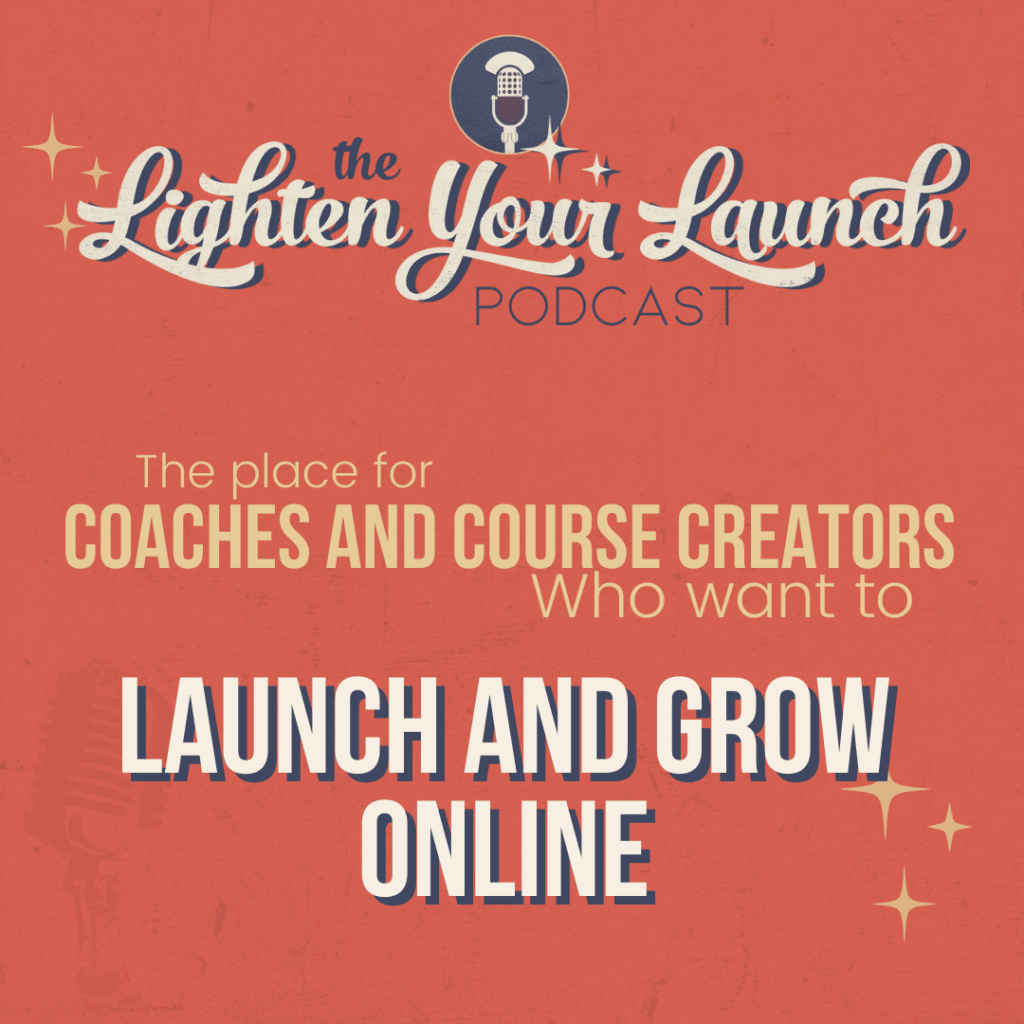
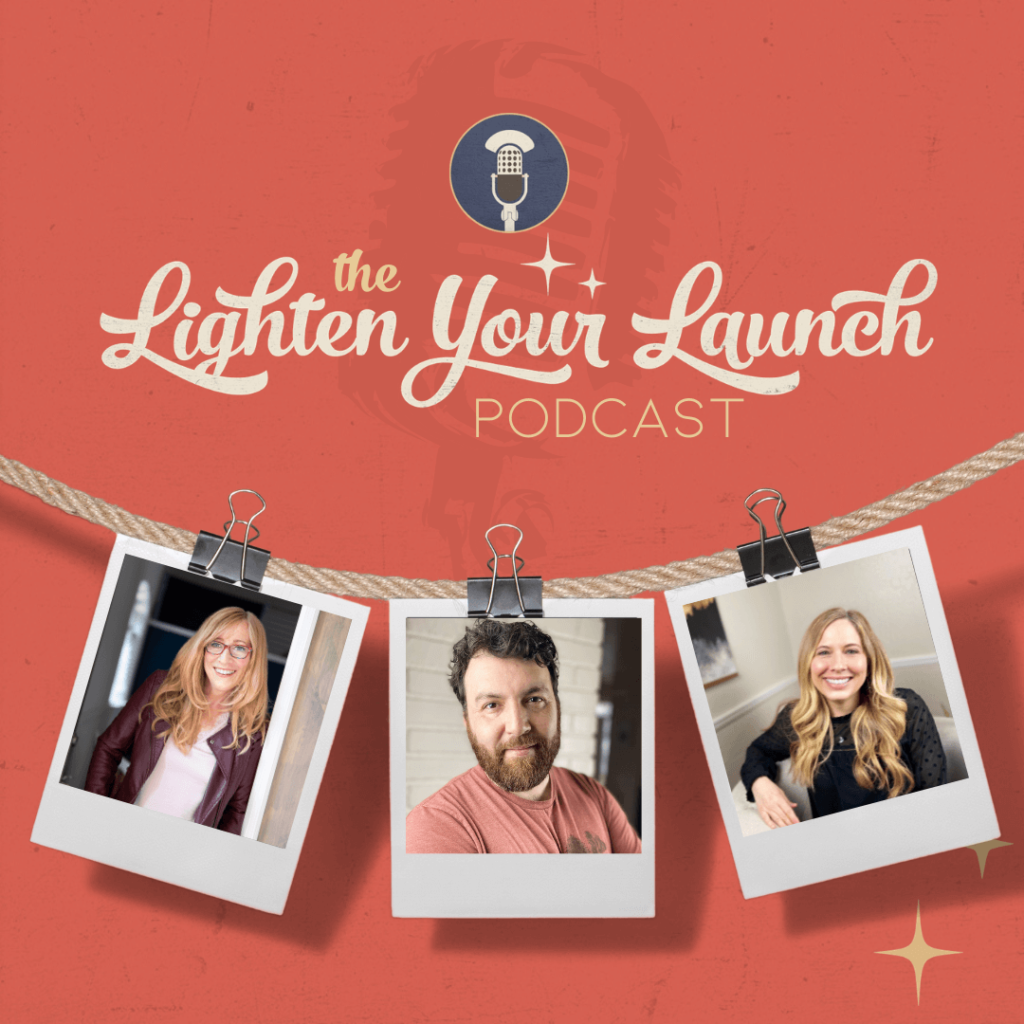


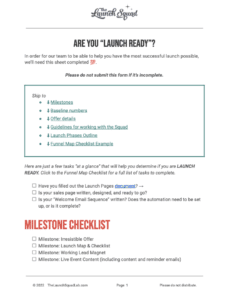
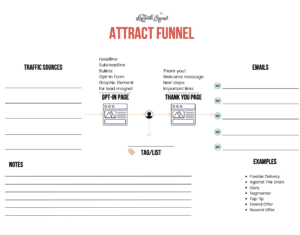
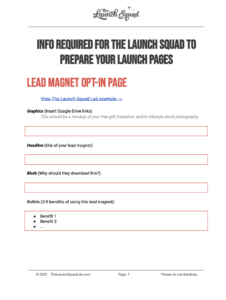
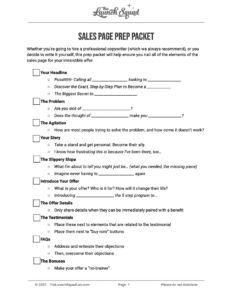
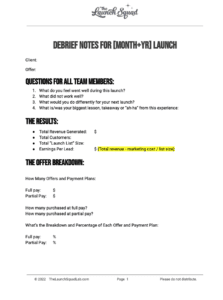
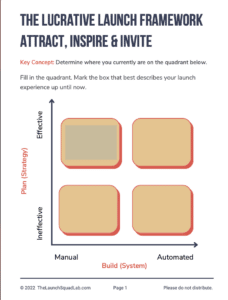
![Marketing Launch Calendar [TEMPLATE]](https://thelaunchsquadlab.com/wp-content/uploads/2023/05/Marketing-Launch-Calendar-TEMPLATE-300x260.png)
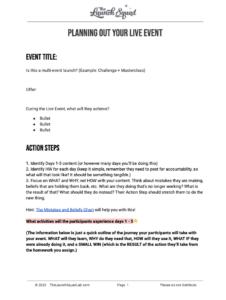
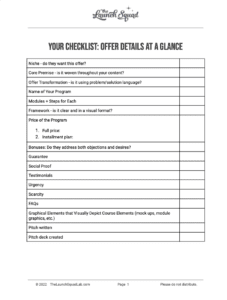
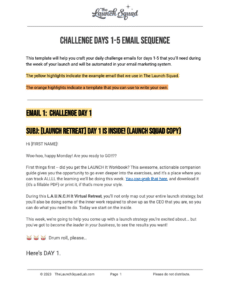
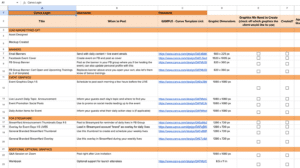
![[Updated] Email Templates for Launch](https://thelaunchsquadlab.com/wp-content/uploads/2023/05/Updated-Email-Templates-for-Launch-223x300.png)
![[REVISED] LS Pitch Script](https://thelaunchsquadlab.com/wp-content/uploads/2023/05/REVISED-LS-Pitch-Script-2023-226x300.png)

